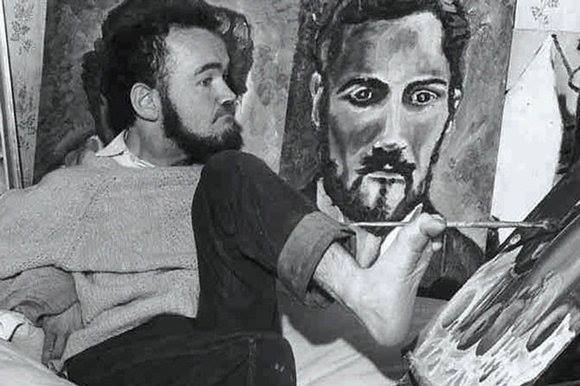
Today we remember Christy Brown who died on this day, 1981. Christy was born in the Rotunda Hospital in Dublin 1932 to a working class family in Crumlin. His father was a bricklayer and his Mother who had 12 other children was the constant support to Christy during his younger years. After his birth, doctors discovered that he had severe cerebral palsy, a serious neurological disorder which left him almost entirely paralyzed by spasticity in his limbs. Though urged to commit him to a convalescent hospital, Brown's parents were unswayed and subsequently determined to raise him at home with their other children. During Brown's adolescence, social worker Katrina Delahunt became aware of his story and began to visit the Brown family regularly, while bringing Christy books and painting materials as he had, beginning years earlier, demonstrated keen interest in the arts and literature and also extremely impressive physical dexterity since, soon after discovering several household books, Christy had learned to both write and draw himself with the only limb over which he had unequivocal control - his left leg. Brown quickly matured into a serious artist. Although Brown famously received almost no formal schooling during his youth, he did attend St Brendan's School Clinic in Sandymount intermittently. At St. Brendan's he came in contact with Dr Robert Collis, a noted author. Collis discovered that Brown was also a natural novelist and later Collis helped use his own connections to publish My Left Foot, by then a long gestating autobiographical account of Brown's struggle with everyday life amidst the vibrant culture of Dublin. When My Left Foot became a literary sensation, one of the many people who wrote letters to Brown was married American woman Beth Moore. Brown and Moore became regular correspondents and in 1960 Brown holidayed in North America and stayed with Moore at her home in Connecticut. When they met again in 1965 they began an affair. Brown journeyed to Connecticut once more to finish his "magnus opus," which he had been developing for years. He finally did so in 1967 with help from Moore, who introduced and administered a strict working regimen, mostly by denying him alcohol (on which Brown was dependent) until a day's work was completed. The book, titled Down All the Days, was published in 1970 and was inscribed with a dedication to Moore that read, "For Beth, who with such gentle ferocity, finally whipped me into finishing this book..."During this time, Brown's fame continued to spread internationally and he became a prominent celebrity. Upon his return to Ireland, he was able to use proceeds from the sales of his books to design and move into a specially constructed home outside Dublin with his sister's family. Though Brown and Beth had planned to marry and live together at the new home, and though Moore had informed her husband of these plans, it was around this time that Brown began an affair with English woman Mary Carr, who he met at a party in London. Brown then terminated his affair with Moore and married Carr in 1972. They moved to Kerry and then to Somerset. He continued to paint, write novels, poetry and plays. His 1974 novel, A Shadow on Summer, was based on his relationship with Moore, who he still considered a friend. While living in England, Brown's addiction to alcohol became more pronounced as his marriage to Mary Carr had, reportedly, become unhappy, and he died suddenly at his home in 1981. The coroner recorded a verdict of death by misadventure, stating that Brown had succumbed to the effects of shock as a result of asphyxiation while eating a pork chop. Accusations were made by Brown's family that implied his death was precipitated by neglect that contributed to both his ill health and his demise. He is buried in the Glasnevin Cemetery, Dublin.



